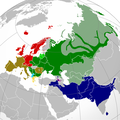Ficheiro:Indo-European branches map.png

Tamaño desta vista previa: 599 × 600 píxeles. Outras resolucións: 240 × 240 píxeles | 479 × 480 píxeles | 767 × 768 píxeles | 1.023 × 1.024 píxeles | 2.045 × 2.048 píxeles | 2.934 × 2.938 píxeles.
Ficheiro orixinal (2.934 × 2.938 píxeles; tamaño do ficheiro: 2,16 MB; tipo MIME: image/png)
Historial do ficheiro
Prema nunha data/hora para ver o ficheiro tal e como estaba nese momento.
| Data/Hora | Miniatura | Dimensións | Usuario | Comentario | |
|---|---|---|---|---|---|
| actual | 26 de setembro de 2022 ás 03:43 |  | 2.934 × 2.938 (2,16 MB) | Alexikoua | minor fixes |
| 30 de marzo de 2022 ás 15:58 |  | 2.934 × 2.938 (1,74 MB) | Whoop whoop pull up | Whoops, wrong file! | |
| 30 de marzo de 2022 ás 15:37 |  | 2.048 × 2.048 (980 kB) | Whoop whoop pull up | Misc fixes (Russian minority in Svalbard & Israel, Slovenian in SE Carinthia, Greek in N Epirus, Aromanians/Megleno-Romanians, Swedish essentially extinct in Estonia, etc. | |
| 22 de decembro de 2021 ás 09:37 |  | 2.934 × 2.938 (1,74 MB) | Ahmet Q. | Reverted to version as of 19:55, 23 August 2021 (UTC)seek consensus for your changes | |
| 25 de novembro de 2021 ás 20:40 |  | 2.934 × 2.938 (2,16 MB) | Alexikoua | rv elimination of Greek minority in Albania | |
| 23 de agosto de 2021 ás 19:55 |  | 2.934 × 2.938 (1,74 MB) | Ahmet Q. | Rv false edit summary. Overrepresentation of Greeks in Turkey, Albania and Ukraine. Unexplained removal of Romanian in Serbia. Overall deterioration of the original file. Seek consensus for your changes. | |
| 7 de agosto de 2021 ás 16:16 |  | 2.934 × 2.938 (2,16 MB) | Demetrios1993 | Addition of Arbereshe linguistic minority in Sicily. Addition of Serbian, Bosnian, and Gorani linguistic minorities in Kosovo. Addition of Greek linguistic minorities in Italy, Albania, Turkey, and Ukraine. Including some other minor corrections. | |
| 19 de novembro de 2020 ás 17:00 |  | 2.934 × 2.938 (1,74 MB) | Golden | update Armenian | |
| 31 de marzo de 2018 ás 18:42 |  | 1.479 × 1.479 (574 kB) | Maphobbyist | Removed area that exactly corresponds to the non-Indo European Lezgi linguistic area. | |
| 6 de setembro de 2016 ás 21:37 |  | 1.479 × 1.479 (620 kB) | Rob984 | Georgia and Azerbaijan aren't majority multilingual. Older generations speak Russian from the Soviet era but now English is taught mainly in place of Russian. More people speak English in Finland, yet that isn't coloured. Also corrections to Celtic are... |
Uso do ficheiro
A seguinte páxina usa este ficheiro:
Uso global do ficheiro
Os seguintes wikis empregan esta imaxe:
- Uso en ast.wikipedia.org
- Uso en ban.wikipedia.org
- Uso en be-tarask.wikipedia.org
- Uso en be.wikipedia.org
- Uso en bg.wikipedia.org
- Uso en cs.wikipedia.org
- Uso en da.wikipedia.org
- Uso en de.wikipedia.org
- Uso en en.wikipedia.org
- Uso en en.wikiversity.org
- Uso en es.wikipedia.org
- Uso en et.wikipedia.org
- Uso en eu.wikipedia.org
- Uso en fa.wikipedia.org
- Uso en fi.wikipedia.org
- Uso en frr.wikipedia.org
- Uso en fr.wikipedia.org
- Uso en gu.wikipedia.org
- Uso en gv.wikipedia.org
- Uso en hak.wikipedia.org
- Uso en he.wikipedia.org
- Uso en hy.wikipedia.org
- Uso en hyw.wikipedia.org
- Uso en ilo.wikipedia.org
- Uso en incubator.wikimedia.org
- Uso en io.wikipedia.org
- Uso en it.wikipedia.org
Ollar o uso global deste ficheiro.

